Reassessing - Study guides, Class notes & Summaries
Looking for the best study guides, study notes and summaries about Reassessing? On this page you'll find 547 study documents about Reassessing.
Page 3 out of 547 results
Sort by
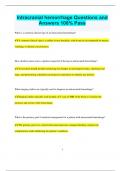
-
Intracranial hemorrhage Questions and Answers 100% Pass
- Exam (elaborations) • 17 pages • 2024
-
Available in package deal
-
- $9.99
- + learn more
Intracranial hemorrhage Questions and Answers 100% Pass What is a common clinical sign of an intracranial hemorrhage? A common clinical sign is a sudden severe headache, which may be accompanied by nausea, vomiting, or altered consciousness. How should a nurse assess a patient suspected of having an intracranial hemorrhage? Assessment should include monitoring for changes in neurological status, checking vital signs, and performing a detailed neurological examination to identify any...
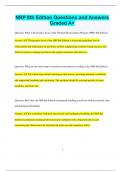
-
NRP 8th Edition Questions and Answers Graded A+
- Exam (elaborations) • 15 pages • 2024
-
Available in package deal
-
- $9.99
- + learn more
NRP 8th Edition Questions and Answers Graded A+ Question: What is the primary focus of the Neonatal Resuscitation Program (NRP) 8th Edition? Answer: The primary focus of the NRP 8th Edition is to provide guidelines for the resuscitation and stabilization of newborns at birth, emphasizing evidence-based practices and skills necessary to manage newborns who require assistance after delivery. Question: What are the initial steps in newborn resuscitation according to the NRP 8th Edition...
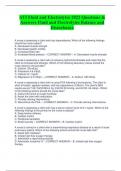
-
ATI Fluid and Electrolytes 2022 Questions & Answers Fluid and Electrolytes Balance and Disturbance A nurse is assessing a client who has hyperkalemia. Which of the following findings should the nurse expect? A. Decreased muscle strength B. Decreased gastr
- Exam (elaborations) • 18 pages • 2023
-
- $17.99
- + learn more
ATI Fluid and Electrolytes 2022 Questions & Answers Fluid and Electrolytes Balance and Disturbance A nurse is assessing a client who has hyperkalemia. Which of the following findings should the nurse expect? A. Decreased muscle strength B. Decreased gastric motility C. Increased heart rate D. Increased blood pressue ---CORRECT ANSWER--- A. Decreased muscle strength A nurse is assessing a client who is receiving hydrochlorothiazide and notes that the client is confused and lethargic. Which of t...
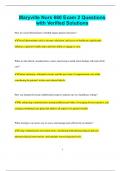
-
Maryville Nurs 660 Exam 2 Questions with Verified Solutions
- Exam (elaborations) • 42 pages • 2024
-
Available in package deal
-
- $11.49
- + learn more
Maryville Nurs 660 Exam 2 Questions with Verified Solutions How do social determinants of health impact patient outcomes? Social determinants such as income, education, and access to healthcare significantly influence a patient's health status and their ability to engage in care. What are the ethical considerations a nurse must keep in mind when dealing with end-of-life care? Patient autonomy, informed consent, and the provision of compassionate care while considering the pati...
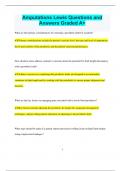
-
Amputations Lewis Questions and Answers Graded A+
- Exam (elaborations) • 13 pages • 2024
-
Available in package deal
-
- $9.99
- + learn more
Amputations Lewis Questions and Answers Graded A+ What are the primary considerations for selecting a prosthetic limb for a patient? Primary considerations include the patient’s activity level, the type and level of amputation, the fit and comfort of the prosthesis, and the patient’s personal preferences. How should a nurse address a patient’s concerns about the potential for limb length discrepancy with a prosthetic limb? Address concerns by explaining that prosthetic limbs a...

-
ATI Pharmacology Proctor 2019/exam updated A nurse is assessing a client who is receiving intravenous therapy. The nurse should identify which of the following findings as a manifestation of fluid volume excess? a. Decreased bowel sounds b. Distended nec
- Exam (elaborations) • 22 pages • 2024
-
- $13.99
- + learn more
ATI Pharmacology Proctor 2019/exam updated A nurse is assessing a client who is receiving intravenous therapy. The nurse should identify which of the following findings as a manifestation of fluid volume excess? a. Decreased bowel sounds b. Distended neck veins c. Bilateral muscle weakness d. Thread pulse b. Distended neck veins A nurse is caring for a client who has hyponatremia and is receiving an infusion of a prescribed hypertonic solution. Which of the following findings should i...
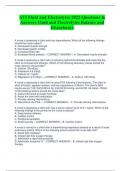
-
ATI Fluid and Electrolytes 2022 Questions & Answers Fluid and Electrolytes Balance and Disturbance A nurse is assessing a client who has hyperkalemia. Which of the following findings should the nurse expect? A. Decreased muscle strength B. Decreased ga
- Exam (elaborations) • 18 pages • 2024
-
- $16.99
- + learn more
ATI Fluid and Electrolytes 2022 Questions & Answers Fluid and Electrolytes Balance and Disturbance A nurse is assessing a client who has hyperkalemia. Which of the following findings should the nurse expect? A. Decreased muscle strength B. Decreased gastric motility C. Increased heart rate D. Increased blood pressue ---CORRECT ANSWER--- A. Decreased muscle strength A nurse is assessing a client who is receiving hydrochlorothiazide and notes that the client is confused and lethargic...

-
ATI Pharmacology Proctor 2019/exam updated A nurse is assessing a client who is receiving intravenous therapy. The nurse should identify which of the following findings as a manifestation of fluid volume excess? a. Decreased bowel sounds b. Distended neck
- Exam (elaborations) • 22 pages • 2024
-
- $20.49
- + learn more
ATI Pharmacology Proctor 2019/exam updated A nurse is assessing a client who is receiving intravenous therapy. The nurse should identify which of the following findings as a manifestation of fluid volume excess? a. Decreased bowel sounds b. Distended neck veins c. Bilateral muscle weakness d. Thread pulse b. Distended neck veins A nurse is caring for a client who has hyponatremia and is receiving an infusion of a prescribed hypertonic solution. Which of the following findings should indicate ...

-
SDI Psychology Test Questions Solved 100% Correct |Verified Answers
- Exam (elaborations) • 11 pages • 2024
-
- $12.49
- + learn more
attachemtn - Answer An important aspect of human life is__________— a feeling of closeness toward another person. False - Answer T/F: In late adulthood, according to Levinson (1986), people go through a midlife transition, a period of reassessing goals, setting new ones, and preparing for the rest of life. Foreclosure - Answer Identity _______ is a state of reaching firm decisions without much thought
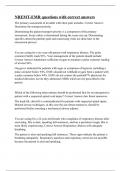
-
NREMT-EMR questions with correct answers
- Exam (elaborations) • 21 pages • 2024
- Available in package deal
-
- $14.99
- + learn more
The primary assessment of an adult with chest pain includes: Correct Answer-Determine the transport priority. Determining the patient transport priority is a component of the primary assessment. Scene safety is determined during the scene size up. Determining specifics about the patients pain and reassessing vitals are done later in the assessment process. You are caring for a six-year-old patient with respiratory distress. The pulse oximeter (Sa02) reads 93%. Your management of the patient ...

How much did you already spend on Stuvia? Imagine there are plenty more of you out there paying for study notes, but this time YOU are the seller. Ka-ching! Discover all about earning on Stuvia


